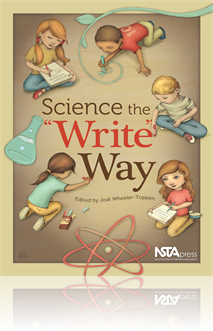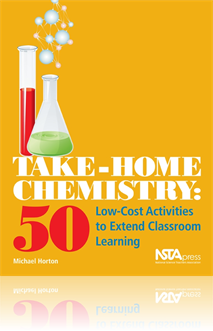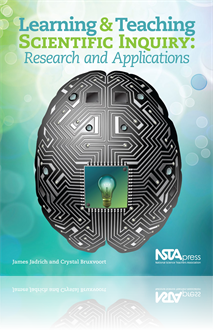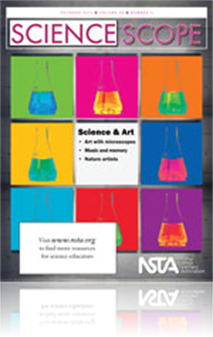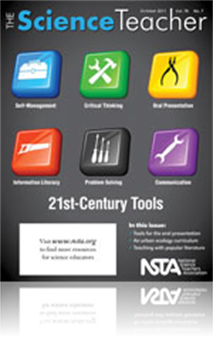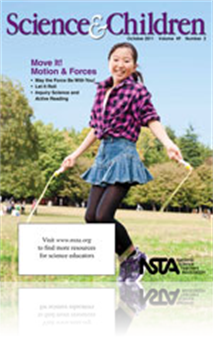All Resources
eBook
Science the “Write” Way (e-book)
Writing skills are high on the list of real-world requirements for all students—including science students. Every scientific discipline needs professionals who can ably communicate in writing. Scientists must be able to describe their proposed stud...
Book Chapter
In this activity, students will make a series of liquid layers with different densities using nontoxic chemicals. This free activity includes the Teacher Pages and Student Pages for this activity and the Table of Contents, Introduction, and Index...
Book Chapter
Building Models in the Classroom
In this chapter, the author will go into more detail about using MBST in the lab and field, focusing on the practical concerns and techniques of model building in the science classroom. ...
Book Chapter
The Creative Processes of Science
In this chapter, the author examines a way to create new problems for your students to solve in the lab and field. Also looks at ways to stimulate our students to think creatively about the meaning and structure of scientific models in general. Creat...
Book Chapter
MBST and the Scientific Worldview
In this chapter, the author outlines the elements of a model of science in several operational social and personal contexts. Once you developed a model for these contexts, you will look at ways you might ways might contextualize science in your class...
Book Chapter
Can science really provide us with the ultimate answers to life, the universe, and everything? To answer this question and others, we first have to understand models. What are they? How do they work? Why do we use them? Once we have this background, ...
Book Chapter
Mental models provide us with a framework for understanding Models-Based Science Teaching (MBST), as well as some of the tenets and limitations of science suggested by philosophers of science. This chapter is background reading for anyone who wants t...
Book Chapter
This chapter will provide you, as a teacher, with an overview of science: where it comes from, what it is, and how it relates to the MBST model. The chapter begins by defining science and exploring its relationship with its first cousin, technology. ...
Book Chapter
In this chapter, the authors take a look at the three most common forms of communication used in science: verbal, written, and graphical. They will also discuss general guidelines for using communication in an inquiry-based science classroom so that ...
Book Chapter
Because measurements are an important part of inquiry-based science, teachers need to teach measurement skills to their students. Doing so requires a basic understanding of measurement theory and must take into consideration students’ levels of dev...
Book Chapter
Observation is frequently called the most basic of all the scientific skills. Ideally, observations should not include any assumptions, interpretations, opinions, or conclusions on the part of the observer. You should never attempt to explain why som...
Book Chapter
A desire to sort and group objects that have similar characteristics is innate to humans. In science, the process of grouping and organizing items and ideas into categories in accordance with specific rules is known as classification. Scientific clas...
Book Chapter
Scientific Inquiry and Scientific Literacy
This chapter provides an overview of what the authors present in this book as well as how the book is laid out. The authors present a synthesis of research findings drawn from science education, cognitive psychology, and developmental psychology rele...
Book Chapter
To better understand scientific inquiry and how to teach inquiry-based science, full consideration of the uses, purposes, and limitations of models is important. The information presented in this chapter is a summary of important features related to ...
Book Chapter
Scientific Models and Conceptual Change
For children to progress and develop more robust scientific models, they need to evaluate their simple models against the evidence available to them in science, then choose to modify or even abandon their current models in favor of ones that are mo...
Book Chapter
Evaluating Variables, Explanations, and Models
Two components of scientific inquiry—designing tests and analysis—are important parts of most scientific investigations, Designing and carrying out good and fair investigations of scientific models are more difficult than analyzing data and think...
Book Chapter
Problem solving tends to be messy. Every problem is different, and each one calls for a slightly different approach. Unfortunately, students often have erroneous ideas about what it takes to be good at problem solving, such as “good problem solvers...
Book Chapter
Integrating Content and Scientific Inquiry in Your Lessons
Although no single lesson-planning approach will work every time for every student in every situation, researchers continue to conclude that one particular approach outperforms any other when it comes to effectively teaching scientific concepts. This...
Book Chapter
Documentation and Research Paper Setup
After organizing the raw data from your experiment and performing statistical analysis, you are ready to move to the next part of your research project—sharing the results of your experiment. You do this by writing a STEM research paper and/or prep...
Book Chapter
Presenting the STEM Research Project
An important part of conducting research for all STEM professionals is to communicate their study results. This is generally accomplished in two different ways. The first is to write a scientific paper, in order to have the paper published in a STEM ...
Book Chapter
Graphical representations are visual ways to represent raw data, descriptive statistics, or inferential statistics in order to highlight important findings from a research study. You can use the graphical representations to determine additional stati...
Book Chapter
Inferential Statistics and Data Interpretation
This chapter is organized into two parts. In the first part, the author briefly introduces inferential statistical tests that are commonly used in STEM research. The description of these tests is meant only to provide an overview and to help you dete...
Book Chapter
After you have begun background research on your topic and have a preliminary hypothesis, you will write your proposal. A proposal is a document that describes the proposed experimental design of your research project. Essentially, it is a paper writ...
Book Chapter
Once you have collected data from your experiment, you will need to calculate various descriptive statistics explained in this chapter. This chapter contains guidelines on how to graphically represent data and provide tips on using description and in...
Journal Article
Integrating the worlds of art and science can be a perfect tool for engaging students in science. One way to make this connection is to explore the life and work of great nature artists of the past and present....
Journal Article
Safer Science: Pregnant in the Laboratory
This column provides best safety practices for the science classroom and laboratory. In this month’s issue, pregnancy policy in the laboratory is discussed....
Journal Article
The New Teacher's Toolbox: Making Your Mark
This column shares tips for teachers just beginning their career. This month’s issue discusses making a name for yourself as a teacher and developing a good reputation....
Journal Article
Apps for Ancient Civilizations
This project incorporates technology and a historical emphasis on science drawn from ancient civilizations to promote a greater understanding of conceptual science. In the Apps for Ancient Civilizations project, students investigate an ancient cultur...
Journal Article
The authors developed a smART—science meets art—concept and created a summer camp for seventh-, eighth-, and ninth-grade students that combines art and science to teach about topics such as biology, chemistry, and physics. They also describe how ...
Journal Article
Science Shorts: How Many Ways Are There to Move?
This column provides classic classroom activities that emphasize science process skills. In this month’s issue the author uses the 5E learning cycle with third- and fourth-grade students to teach that a force is a push or pull....
Journal Article
The author works with a chorus teacher to create an interdisciplinary unit using music to supplement the science curriculum. This particular subject involved creating lyrics and music to help students learn cellular components vocabulary....
Journal Article
Recognizing Excellence: From Macro to Micro to Nano
This column features profiles of award-winning science programs and teachers. In this month’s issue the author shares his experience of working with a university researcher. Third-grade students benefit from this relationship and learn about the na...
Journal Article
The 21st-Century Oral Presentation Tool Bag
The author provides suggestions and tools to help teachers implement successful oral presentations in their science classrooms....
Journal Article
Science 2.0: Combine Your Technologies for 21st-Century Results
This column shares web tools that support learning. In this month’s issue, the author discusses using combinations of technologies so students can complete open-ended tasks, which offer opportunities to practice 21st-century skills....
Journal Article
Career of the Month: Visualization Scientist
This column shares interviews with professionals using science in the workplace. In this month’s issue Carter Emmart describes what it is like to be a visualization scientist....



